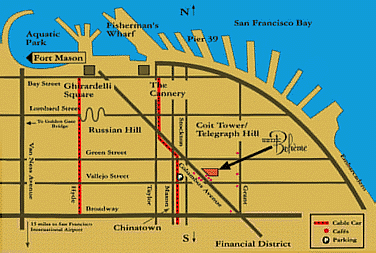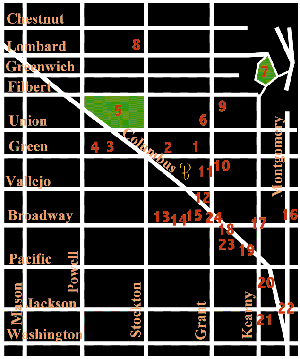
In the heart of North Beach,
within easy walking
distance of:
Cable Cars : 3 min.
Chinatown : 4 min.
Coit Tower : 10 min.
Lombard St. : 9 min.
Fisherman's Wharf : 12 min.
Financial District : 10 min.
Pier 39 : 10 min.
During your stay, we’ll be happy
to provide you with a copy of this
most unusual and unique walking tour…

To begin the tour, head out the Bohème front door and turn right. Go to the corner and turn right again onto Green Street.
Stop 1 is Mr. Otis at 532 Green Street. This was an important meeting place for poets and painters in the late ‘50s. It was considered the center for groups of artists who came together for mutual inspiration.
Retrace your steps to 576 Green, next to Caffe Sport. Stop 2 is the former home of The Cellar, the most famous of the San Francisco clubs that featured jazz and poetry. Kenneth Rexroth and Lawrence Ferlinghetti regularly gave readings here accompanied by jazz and even managed to record some of the happenings.
Stop 3 on your tour is directly across Green Street, which for one block only between Columbus and Powell, has been renamed Beach Blanket Babylon Blvd. in honor of the famous musical comedy by the same name. The show has been sold out virtually every night since its opening back in the early ‘70s. As you move along this short block , you will see an inviting group of tables nestled up against a green wall at O’Reilly’s Irish Pub & Restaurant. This is a must see for the life-size mural of famous Irish writers such as Joyce and Yeats. The mural was painted by local muralist Vramas van Hoyt. Stop in and say hi to Myles, the ever-welcoming owner!
Stop 4 is Fugazi Hall at 678 Beach Blanket Babylon Blvd., next door to O’Reilly’s. This was the setting for poetry readings by James Broughton, Michael Greg and Michael McClure. The 1958 Poets'’Follies were held here.
Now turn right onto Powell, go down one block and cross over to Stop 5, which is Washington Square Park. This has always been a favorite spot to catch the sun in North Beach; Kerouac himself could often be found here, relaxing and enjoying a bottle or two of port. The park is always a popular destination on sunny days, and if you rise early enough in the morning, you can watch the quiet grace of sometimes hundreds of people practicing Tai Chi. With the park’s close proximity to Coit Liquor, you can carry on in the style of Kerouac!
Now continue along to 510 Union Street for Stop 6. This is the Bread and Wine Mission which has been described as "a medieval church to the community," a center for artists, poets. It is also famous for the Sunday "agape dinners" as portrayed in the movie "The Subterranean’s."

For Stop 7 best get your hiking legs ready. You’re heading way up to Coit Tower located at the top of Telegraph Hill. The tower marks the point where the first West Coast telegraph messages were received that notified the arrival of ships from the Pacific . The views are magnificent, and spectacular WPA murals can be seen in the lobby of the tower daily from 10 a.m. to 7 p.m. There is extraordinary and interesting detail in these murals. I encourage you to really take your time here.
Stop 8 is at the northwest corner of Bob Kaufman Alley (originally Harwood Alley), a former residence of, that’s right, Bob Kaufman. Kaufman was published by City Lights then picked up by the avant-garde publisher New Directions, as well as a number of foreign publishers. Extremely popular in France, Kaufman is known as the black American Rimbaud.
Traveling down Grant Avenue, you will find "The Place" at 546 Grant for Stop 9. This was an underground Bohemian hangout from the ‘40s to the ‘60s. It was a center for showing underground painters (e.g. Wally Hedrick projected early liquid-light shows on the walls, and paintings by Robert LaVigne and Jy Defco hung here). "The Place" was managed by Knute Stiles and Leo Krikorian, both Black Mountain College alumni. What started as Dada Night evolved in the late ‘50s into Blabbermouth Night, an open social forum.
Continue along to 1398 Grant Avenue which is Stop 10. This is the former site of the Co-Existence Bagel shop where a delicatessen "collided" with a beer-joint-hangout and news center. It was immortalized by Bob Kaufman in Bagel Shop Jazz who describing its regulars as "shadow people… mulberry-eyed girls in black stockings, smelling vaguely of mint jelly… turtle neck angel guys… coffee-faced ivy Leaguers… who’s Harvard was a Fillmore District step." Sadly, the shop closed in 1960. North Beach Video is the current occupant.
Stop 11 takes you to the Coffee Gallery at 1353 Grant Avenue. This is just up the street from the still famous Café Trieste. Formerly Miss Smith’s Tea Room and currently the Lost and Found Saloon, this is a center for poetry, jazz, and art, and also the site of "Speak-Up" nights and other open forums. Lord Buckley performed here and the bar still attracts a wild mix of urban locals, mad writers, and live music!
Travel down to the corner for Stop 12. At 601 Vallejo Street, Café Trieste has remained unchanged since the time of the Beats. Writers and artists gather here to linger infinitely over cups of coffee, to write and discuss their work or recover from activities of the night before. The tradition continues and you will probably bump into a struggling poet or two and perhaps hear an opera sung by one of the owners on Saturday afternoons around 1:30 p.m.!
Follow Grant Avenue to Broadway, make a left turn and you’ll encounter Stop 13, the Marconi Hotel located at 554 Broadway. In 1954, Allen Ginsburg stayed in this hotel when he arrived in San Francisco (This was many years prior to the founding of Hotel Bohème!).
Stop 14, is Columbus Discount Bookstore. Up above, was the Swiss American Hotel where Lenny Bruce made his infamous dive out of his hotel window (Don't worry, he lived to tell about it!). The hotel is currently senior housing.
Now for one of our favorite stops, Stop 15, Enrico’s at 504 Broadway. Here you’ll discover a beautifully refurbished landmark of the Beat Generation and again, another great jazz joint. The front patio is always crowded, and everyone gathers inside nightly after 9 p.m. for the outstanding jazz.
Now continue East on Broadway (away from Columbus) walking past Kearny to Montgomery Street. Turn left and go up to 1010 Montgomery Street for Stop 16. Allen Ginsberg and Peter Orlovsky lived here from February 3rd to September 6th 1955. It was in these digs that Ginsberg wrote Howl, to the shock of obscenity wardens throughout the land. He first read the poem publicly at the famous Six Gallery, a landmark monument of the Beat Movement. The Six Gallery is highlighted at the end of the tour.
For Stop 17, walk back down to Broadway, then turn right and cross the street. Go over to 493 Broadway. This location used to be Rumors, where during the Iraq War, local poets expressed their collective rage about it in nightly readings. The Sunday evening readings, which generated as many as 500 poets, artists, and guests, were open to the public as recently as last year.
Stop 18 leads you down to the corner of 256 Columbus, where the original La Bodega (as seen in the Hotel Bohème photo gallery) used to be. This place became well known in the ‘50s for hosting all night wine and pasta feeds for whomever happened to stop by. It hosted many European dignitaries, and is now the site of Jazz at Pearl’s, currently famous for the tough two-drink minimum (and no cover!)!
Head downhill to Stop 19, Spec’s at Saroyan Place. Henri Lenoir’s saloon occupied this space across Columbus (from Vesuvio) on William Saroyan Place. This deadend alley was originally named Adler alley, and Lenoir’s saloon was called 12 Adler Place. When word got out about Vesuvio, many of the writers migrated across the street to this equally dark and rowdy joint (more about Vesuvio later).
Just a step or two down Columbus at Stop 20, Tosca is still a hot hangout. Tosca has been attracting the arts crowd, both young and old, for years. You may recognize this as one of the sites in the Wim Wenders film, Until the End of the World.
Now, slide on down to 599 Jackson at Columbus for Stop 21. The Hungry i is the site of Lenny Bruce’s arrest and of J.F. Goodwin’s Beat opea, The Pizza Pusher.
The Purple Onion, Stop 22, is another establishment still in operation since the ‘50s. This funky club featured various artists such as Woody Allen, Dick Gregory, Mort Sahl, and Lenny Bruce, to name a few. Not to be overlooked was the large contingent of Beats as well. The Onion is currently host to an eclectic mixture of bands.
Stop 23 is at 255 Columbus so cross over Columbus and head back up the hill to Vesuvio. This saloon is where nearly every writer associated with the beat scene in North Beach hung out. It is a classic long-running true Bohemian bar, across the alley from City Lights. Henri Lenoir holds the keys to this still thriving arena for the new beats. The bar is filled with art, poetry, stained glass, projected postcards (instead of televisions!), and lots of memorabilia. Among those who have been 86’d are Dennis Crisp, Bob Miller, Bob Kaufman, Janice Blue, Gregory Corso, Peter Sperm, Two dollar Burt, White Crombie, Fox Lewis, and Paddy O’Sullivan. Look down on the sidewalk out in front and scraped in cement you’ll see a sample of the local talent and a hint of the antics. Care to go in and get "inspired?"
Stop 24 is right across that famous alley called Jack Kerouac Street. At 261 Columbus Avenue, you’ll find City Lights Bookstore, where Murao and Ferlinghetti were arrested for selling copies of Allen Ginsberg’s famous Howl. Lawrence Ferlinghetti can often be found among the stacks of this all-paperback bookstore, which he and Peter D. Martin founded in June of 1953. City Lights has undergone several expansions: it currently occupies three floors and has been packed since the day it opened. City Lights' printing of Allen Ginsberg’s Howl and Other Poems secured its historical place in American literary history after a long obscenity trial in the summer of 1957, when the book was found to have redeeming social value. When you return to Hotel Bohème, take special note of the hallway light fixtures. These are a cornucopia of newspaper clippings, photos, and titles such as Lawrence Ferlighetti’s "Reality Sandwiches."
While this concludes your walking tour, for the stout of heart, there IS one more stop (a 1.8 mile walk from North Beach). Originally the site of a garage, the famous Six Gallery is Stop 25, the stop of stops! Located at 3119 Fillmore Street, between Filbert and Greenwich, it rented for $50 a month and became an alternative space for poets and artists in 1952, when King Ubu Gallery (named after the Alfred Jary play) was founded here by Robert Dincan, Jess Collins, and Haey Jacobus. The gallery was run very informally until it was shut down in 1953. In October 1954, six people opened the Six Gallery in the same space. The group reading there, culminating in the first reading of Howl on October 13, 1955, marked the real beginning of the San Francisco Beat era.
_________________
Links: | san francisco weather | s.f. | beat | hotel info | rooms | top |